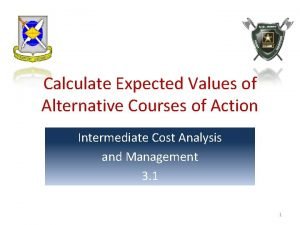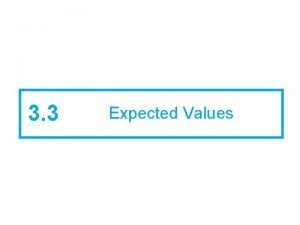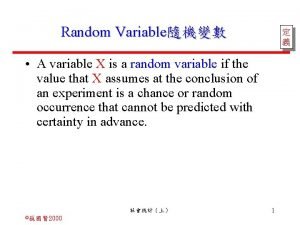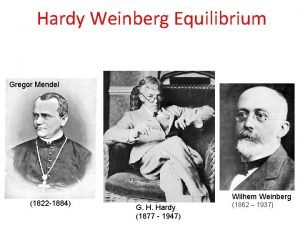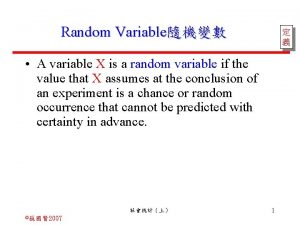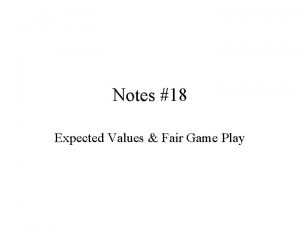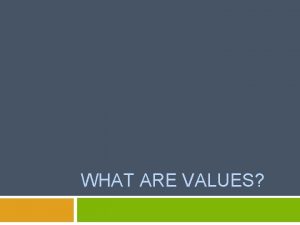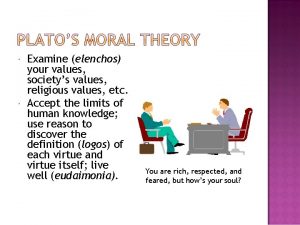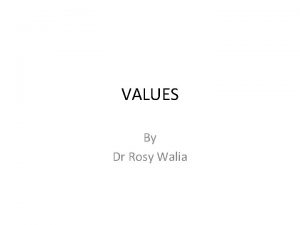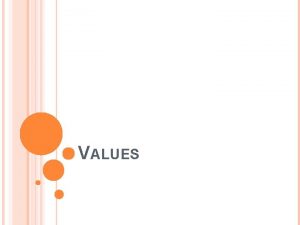Notes 17 Expected Values Expected Values The Expected













- Slides: 13

Notes #17 Expected Values

Expected Values The Expected Value of x is the sum of the products of the values of x and their corresponding probabilities. • E(x) = x 1 P(x 1) + x 2 P(x 2) + x 3 P(x 3) + … + xn P(xn)

Purpose for Expected Values 1) Assists in making mathematically sound decisions for future events. 2) Used when making investments, determining a price for numerous services, prioritizing events, and in calculating return on investment.

Example 1: A third grade class was surveyed regarding the number of hours that they played electronic games each day. The probability distribution is given in the table below: # of Hours (x) Probability P(x) 0 0. 3 1 0. 4 2 0. 2 3 0. 1 Calculate the Expected Value of the quantity of time that a third grader spends each day playing electronic games.

E(x) = x 1 P(x 1) + x 2 P(x 2) + x 3 P(x 3) + … + xn P(xn) # of Hours (x) Probability P(x) 0 0. 3 1 0. 4 2 0. 2 3 0. 1 Expected value, E(x) = 0 (0. 3) + 1 (0. 4) + 2 (0. 2) + 3 (0. 1) Expected value, E(x) = 0 + 0. 4 + 0. 3 Expected value, E(x) = 1. 1 hours Conclusion: Third graders spend 1. 1 hrs playing video games each day.

Example 2: Find the expected number of boys for a three-child family. Assume girls and boys are equally likely. Key: b=Boy; g = Girl # of Boys Probability Product x P(x) bbg 0 1/8 0 bgb 1 3/8 2 3/8 6/8 3 1/8 3/8 Expected Value: E(x) =0 + 3/8 + 6/8 + 3/8 = 12/8 or 1. 5 boys 8 Combos bbb bgg gbb gbg ggb ggg Concl: The expected # of boys for a 3 -child family is 1. 5 boys.

Example 3: Finding Expected Winnings A player pays $3 to play the following game: Win $7 by rolling a 6 on a single die, Win $1 by rolling any other number. What are the expected net winnings for the game? Number 1, 2, 3, 4, 5 6 Payoff Net P(x) x P(x)

Finding Expected Winnings A player pays $3 to play the following game: Win $7 by rolling a 6 on a single die, Win $1 by rolling any other number. What are the expected net winnings for the game? ANS: The player will not have an expected net winning for the game, since his Expected Value is a loss of $1. 00.

Notes #18 Fair Game Play & Expected Value

Fair Games/Expected Value • The expected value of a game is the amount, on average, of money you win per game. The expected value (in terms of a game) is calculated as follows: • E(x) = ($ paid if you win) * (P(winning)) • A game is a fair game when the cost of each game equals the expected value (what you put in, you get out).

Deciding if a Game is Fair, Favors the House, Favors the Player A fair game is one in which the net winnings are zero. An unfair game against the player has a negative expected winnings. An unfair game in favor of the player has a positive expected winnings.

Example 1: Two dice are rolled A player gets $5 if the two dice show the same number, or if the numbers on the dice are different then the player pays $1. Number Payoff P(x) x P(x) Same for both dice $5 6/36 or 1/6 $5 x 1/6 = $5/6 Different number -$1 30/36 or 5/6 -$1 x 5/6 = -$5/6 a. What is the probability of winning $5? ANS: 6/36 or 1/6 probability of winning $5 b. What is the probability of paying a $1? ANS: 30/36 or 5/6 probability of losing $1.

Example 1: A player gets $5 if the two dice show the same number, or if the numbers on the dice are different then the player pays $1. Number Payoff P(x) x P(x) Same for both dice $5 6/36 or 1/6 $5 x 1/6 = $5/6 Different number -$1 30/36 or 5/6 -$1 x 5/6 = $5/6 c. What is the expected value of this game? E(x) = x 1 P(x 1) + x 2 P(x 2) + x 3 P(x 3) + … + xn P(xn) E(x) = $5(1/6) + (-$1)(5/6) = $5/6 – $5/6 = 0 d. The Expected Value is $0. This would be a fair game, neither the House or Player is favored.
 How to calculate estimated value
How to calculate estimated value What is the value of what is the value of
What is the value of what is the value of Var(x)=
Var(x)= Gregor mendel
Gregor mendel Variance of the random variable
Variance of the random variable Cube wisc
Cube wisc Thế nào là mạng điện lắp đặt kiểu nổi
Thế nào là mạng điện lắp đặt kiểu nổi Khi nào hổ mẹ dạy hổ con săn mồi
Khi nào hổ mẹ dạy hổ con săn mồi Dạng đột biến một nhiễm là
Dạng đột biến một nhiễm là Thế nào là sự mỏi cơ
Thế nào là sự mỏi cơ Bổ thể
Bổ thể Vẽ hình chiếu đứng bằng cạnh của vật thể
Vẽ hình chiếu đứng bằng cạnh của vật thể độ dài liên kết
độ dài liên kết Thiếu nhi thế giới liên hoan
Thiếu nhi thế giới liên hoan
